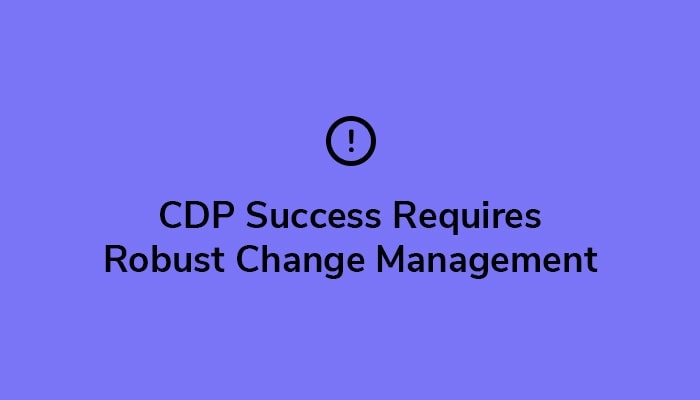Why Your CDP Vendor Must Bring Change Management Expertise

Prior to joining ActionIQ, I served as an analyst at a well-known industry research firm. I was privileged to advise over 200 clients on their CDP initiatives. On numerous occasions, I received a phone call that went something like this:
Senior marketing executive at major brand: “We bought a CDP.”
Me: “How’s it going?”
Marketing executive: “Not well. It’s not getting off the ground.”
Oof.
Technology is Not a Silver Bullet
Surprisingly, it’s not uncommon for leading, superbly-run companies to buy a transformational technology (like a CDP), look at themselves in the mirror and say, “What do I do now?” Digging deeper, I would discover that the companies who called me had spent a lot of time evaluating their selected platform’s technical capability, but not much time planning for the organizational change required to realize the benefit from their new technology or bringing in those with CDP change management expertise.
I’ve seen it time and again: people expect technology to act as a silver bullet, and they end up underestimating the importance and challenge of the change management aspects of a CDP-centric transformation.
As a case in point, let’s take a look at one of the ancillary benefits of a CDP: rationalization of your martech stack. First, we will look at the technical implications, and then the people/process and org implications.
Technical Implications of a CDP

At face value, this looks like an amazing benefit. You’ve cut out six tools from your tech stack. You’ve taken customer data—previously siloed to different departments—and brought them together in a single place.
But now, let’s look at the people, process, and org end of things.
Transitioning From Silos to Unified Hubs
Before, you had people in marketing who acted more like project managers. They coordinated with IT to devise scripts that pulled audiences for a campaign. They “swivel chaired” between multiple systems to integrate data between them, and manually integrated disparate data in Excel, before handing it off to others for use in the channel they owned. These humans were the bandaids between your siloed data, systems, and departments.
Now, with the CDP, everything’s consolidated and centralized. Your customer data is in one place. You can orchestrate across all channels and lines of business from a centralized hub. And everything is set up for marketer self-service. But without org adjustments, you still employ a staff of project managers—when what’s needed now is a staff of do-ers who know the audiences, the data, the messages, and the goal—and are ready to execute hands on. Do you have a plan to train / reassign / hire, so you can have the right personnel in place?
Going From Channel-Centric to Customer-Centric
Before, you had teams aligned around each channel. An email team, a digital team, a direct mail team, and so on. Maybe even further matrixed by product or line of business as well.
Now, all your data and systems are aligned around the customer. And the customer doesn’t care about your org chart or your lines of business. They care about having their needs met. Do you have the right incentives and plan in place to modernize your org structure and put the customer at the center of everything you do?
Skills Sets and Organizational Alignment are Critical
If you don’t have the right personnel, organizational and incentive plans in place to take advantage of the benefits of your new CDP, how could it possibly succeed at the point of go-live? The org will continue to chase after its channel-oriented incentives, will stick to the old IT-dependent systems and processes, and your CDP will not be adopted. The project will fail.
(For more on best practices for aligning your org around the customer, read Tamara Gruzbarg’s blog CDP Change Management: Change Comes from Within).
Leaders of Successful Transformations Obsess About Change Management
While I opened this blog highlighting the calls where a company had made a tech decision before working out the larger organizational considerations, the vast majority of inquiries I received over the years were from executives who were far more concerned about change than they were about technology.
It’s those companies, the ones who have prioritized the organizational, people and process components of their CDP initiative, who succeed with their customer-centric transformations.
That’s why change management is critical. It’s so important, it should actually be a core component of how you evaluate CDPs during your selection process. You should be asking: “In addition to technology, can my CDP vendor serve as a trusted partner to help guide my change management efforts?”
At ActionIQ, we saw early on how our most successful clients had a strong change management strategy. To ensure all our clients were so successful, we began baking our change management learnings into all our pre-, mid-, and post-implementation processes. For us, it’s paid off with an industry-best customer retention rate.
ActionIQ’s Dedication to Change Management Guidance
We have a dedicated practice called Value Mapping, focused on guiding our clients through CDP-centric change management. I encourage you to learn more about it in Ryan Greene’s blog post Planning for CDP Change Management: A Proven Approach.
Within the CDP marketplace, this strategic service is a differentiator for a few key reasons:
- Team. The ActionIQ team is made up of prior practitioners who have bought innovative enterprise software, prior top-tier consultants who’ve advised on organizational change & digital transformation, and previous purchasers of ActionIQ’s CDP.
- Focus. We believe in the value of change management. Our competitors are either CDP startups who don’t have the funding or expertise to provide a change management function, or they’re mega-vendors of marketing clouds who pass it off to high-cost solution integrators to provide change management strategy.
- Value. We offer our strategic change management services for a fraction of the value they bring to ActionIQ clients.
So, when it comes time to planning your CDP initiative, be sure to place a high priority on change management, requiring it to be a heavy part of your vendor evaluation criteria. Your success depends on it.





